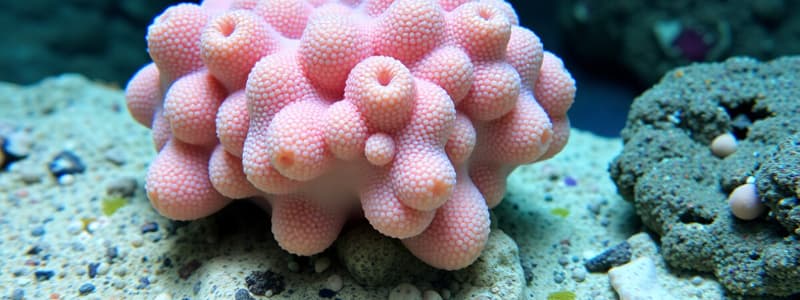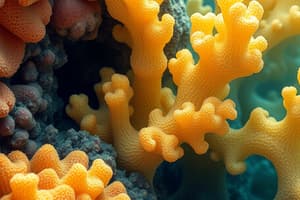Podcast
Questions and Answers
What is the primary characteristic of the Ascon type of sponge?
What is the primary characteristic of the Ascon type of sponge?
- It has multiple openings for water flow.
- It forms a complex branching structure.
- It consists of a group of tubes with a central cavity. (correct)
- It is composed of a single, porous sac.
Which of the following best describes the cellular structure of an Ascon sponge?
Which of the following best describes the cellular structure of an Ascon sponge?
- It has uniform cell types throughout the sponge structure.
- It is entirely formed by a single type of cell without any amoeboid cells.
- It includes an outer lining of indistinct cells and an inner lining of flagellated cells. (correct)
- It consists solely of tightly packed squamous cells.
What is the primary function of the flagellated cells in the Ascon sponge?
What is the primary function of the flagellated cells in the Ascon sponge?
- To form pores that allow for gas exchange.
- To support the sponge's skeletal framework.
- To expel waste products into the surrounding water.
- To create water currents and capture food. (correct)
How does water enter the central cavity of an Ascon-type sponge?
How does water enter the central cavity of an Ascon-type sponge?
What type of environment does the sponge example Leucosolenia thrive in?
What type of environment does the sponge example Leucosolenia thrive in?
What is the primary method of reproduction for Obelia sp.?
What is the primary method of reproduction for Obelia sp.?
Which part of the Obelia sp. serves as the mouth opening surrounded by tentacles?
Which part of the Obelia sp. serves as the mouth opening surrounded by tentacles?
What is the composition of the hydroid stalk in Obelia sp.?
What is the composition of the hydroid stalk in Obelia sp.?
How does Obelia sp. maintain its colony structure?
How does Obelia sp. maintain its colony structure?
What structural feature provides protection for the individual feeding polyp in Obelia sp.?
What structural feature provides protection for the individual feeding polyp in Obelia sp.?
What is the primary method of reproduction in sponges?
What is the primary method of reproduction in sponges?
Which of the following components is NOT found in the body structure of a sponge?
Which of the following components is NOT found in the body structure of a sponge?
What type of sponge is known for having a soft fibrous skeleton and is highly absorbent?
What type of sponge is known for having a soft fibrous skeleton and is highly absorbent?
What occurs after the fertilization of male and female gametes in sponges?
What occurs after the fertilization of male and female gametes in sponges?
Where are good quality sponges commonly found?
Where are good quality sponges commonly found?
What is the scientific name of the Turkey cup sponge?
What is the scientific name of the Turkey cup sponge?
Which of the following is true about the honeycomb sponge?
Which of the following is true about the honeycomb sponge?
What characteristic is common to all sponge types as indicated in the description?
What characteristic is common to all sponge types as indicated in the description?
What is a distinctive feature of the phylum Porifera concerning their cellular structure?
What is a distinctive feature of the phylum Porifera concerning their cellular structure?
Which of the following statements about Porifera is true regarding their symmetry?
Which of the following statements about Porifera is true regarding their symmetry?
What mechanism do Porifera use for water circulation within their bodies?
What mechanism do Porifera use for water circulation within their bodies?
What type of reproduction is NOT characteristic of the phylum Porifera?
What type of reproduction is NOT characteristic of the phylum Porifera?
What is the composition of the internal skeleton found in Porifera?
What is the composition of the internal skeleton found in Porifera?
What is the primary characteristic that differentiates the polyp form from the medusa form in Cnidarians?
What is the primary characteristic that differentiates the polyp form from the medusa form in Cnidarians?
Which of the following classes within the Phylum Coelentrata includes jellyfish?
Which of the following classes within the Phylum Coelentrata includes jellyfish?
What defines the body cavity of Cnidarians?
What defines the body cavity of Cnidarians?
Which structure is primarily responsible for the stinging capability of Cnidarians?
Which structure is primarily responsible for the stinging capability of Cnidarians?
What type of symmetry do organisms in the Phylum Coelentrata exhibit?
What type of symmetry do organisms in the Phylum Coelentrata exhibit?
What is the distinct body shape of a medusa in Cnidaria?
What is the distinct body shape of a medusa in Cnidaria?
Which body shape is characteristic of sea anemones?
Which body shape is characteristic of sea anemones?
Which of the following is NOT a member of the Phylum Cnidaria?
Which of the following is NOT a member of the Phylum Cnidaria?
Coral reefs are primarily composed of which type of organism?
Coral reefs are primarily composed of which type of organism?
What is the primary feature that differentiates Cnidarians from other marine organisms?
What is the primary feature that differentiates Cnidarians from other marine organisms?
What type of skeleton do corals possess?
What type of skeleton do corals possess?
Which of the following organisms is mentioned as a type of coral?
Which of the following organisms is mentioned as a type of coral?
In which type of environments are corals primarily found?
In which type of environments are corals primarily found?
What do corals primarily feed on?
What do corals primarily feed on?
Which of the following statements best describes coral reefs?
Which of the following statements best describes coral reefs?
What distinguishes the Leucon type of sponge from the Sycon type?
What distinguishes the Leucon type of sponge from the Sycon type?
Which of the following best describes the body structure of the Sycon type of sponge?
Which of the following best describes the body structure of the Sycon type of sponge?
Which characteristic is NOT true for the Sycon type of sponge?
Which characteristic is NOT true for the Sycon type of sponge?
What material primarily composes the body structure of the Leucon type sponge?
What material primarily composes the body structure of the Leucon type sponge?
What role do choanocytes play in both Sycon and Leucon sponges?
What role do choanocytes play in both Sycon and Leucon sponges?
What is the primary function of epithelial cells in colonial animals?
What is the primary function of epithelial cells in colonial animals?
Which type of cell in colonial animals can differentiate into various other cell types?
Which type of cell in colonial animals can differentiate into various other cell types?
What substance do glandular cells in colonial animals secrete?
What substance do glandular cells in colonial animals secrete?
Where are stinging cells primarily located in colonial animals?
Where are stinging cells primarily located in colonial animals?
What is the function of sensory cells in colonial animals?
What is the function of sensory cells in colonial animals?
In which class does the organism Aurelia sp. belong?
In which class does the organism Aurelia sp. belong?
What characteristic is typical of the ectoderm in colonial animals?
What characteristic is typical of the ectoderm in colonial animals?
How do stinging cells in colonial animals aid in capturing prey?
How do stinging cells in colonial animals aid in capturing prey?
Flashcards
Sessile Animal
Sessile Animal
An animal that spends its entire life attached to a surface.
Ascon Sponge
Ascon Sponge
A simple sponge type with a central cavity and a single opening (osculum).
Osculum
Osculum
The single opening at the top of an ascon sponge.
Tube cell in ascon
Tube cell in ascon
Signup and view all the flashcards
Water current in sponge
Water current in sponge
Signup and view all the flashcards
Sycon Sponge Structure
Sycon Sponge Structure
Signup and view all the flashcards
Leucon Sponge
Leucon Sponge
Signup and view all the flashcards
Choanocytes
Choanocytes
Signup and view all the flashcards
Inhalant Pores (Sycon)
Inhalant Pores (Sycon)
Signup and view all the flashcards
Spongin
Spongin
Signup and view all the flashcards
Porifera phylum
Porifera phylum
Signup and view all the flashcards
Sponges' symmetry
Sponges' symmetry
Signup and view all the flashcards
Water flow in Porifera
Water flow in Porifera
Signup and view all the flashcards
Porifera skeleton
Porifera skeleton
Signup and view all the flashcards
Porifera reproduction
Porifera reproduction
Signup and view all the flashcards
Radial Symmetry in Coelenterata
Radial Symmetry in Coelenterata
Signup and view all the flashcards
Coelenteron
Coelenteron
Signup and view all the flashcards
Cnidocytes
Cnidocytes
Signup and view all the flashcards
Alternation of Generations in Coelenterata
Alternation of Generations in Coelenterata
Signup and view all the flashcards
Hydrozoa, Scyphozoa, Anthozoa
Hydrozoa, Scyphozoa, Anthozoa
Signup and view all the flashcards
Sponge Body Structure
Sponge Body Structure
Signup and view all the flashcards
Sponge Reproduction (Asexual)
Sponge Reproduction (Asexual)
Signup and view all the flashcards
Sponge Reproduction (Sexual)
Sponge Reproduction (Sexual)
Signup and view all the flashcards
Sponge Economic Importance
Sponge Economic Importance
Signup and view all the flashcards
Turkey Cup Sponge
Turkey Cup Sponge
Signup and view all the flashcards
Honeycomb Sponge
Honeycomb Sponge
Signup and view all the flashcards
Sponge Fisheries in Egypt
Sponge Fisheries in Egypt
Signup and view all the flashcards
Sponge Depth
Sponge Depth
Signup and view all the flashcards
Cnidaria body shapes
Cnidaria body shapes
Signup and view all the flashcards
Cnidaria example organisms
Cnidaria example organisms
Signup and view all the flashcards
Cnidarians and coral reefs
Cnidarians and coral reefs
Signup and view all the flashcards
Medusa form
Medusa form
Signup and view all the flashcards
Polyp form
Polyp form
Signup and view all the flashcards
Obelia sp. Colony Structure
Obelia sp. Colony Structure
Signup and view all the flashcards
Feeding Polyp
Feeding Polyp
Signup and view all the flashcards
Hydroid Stem
Hydroid Stem
Signup and view all the flashcards
Obelia sp. Habitat
Obelia sp. Habitat
Signup and view all the flashcards
Colony Formation
Colony Formation
Signup and view all the flashcards
Colonial Animal Layers
Colonial Animal Layers
Signup and view all the flashcards
Epithelial Cells (Digestive)
Epithelial Cells (Digestive)
Signup and view all the flashcards
Stinging Cells
Stinging Cells
Signup and view all the flashcards
Jellyfish Class
Jellyfish Class
Signup and view all the flashcards
Sensory Cells
Sensory Cells
Signup and view all the flashcards
Glandular Cells
Glandular Cells
Signup and view all the flashcards
Interstitial Cells
Interstitial Cells
Signup and view all the flashcards
Location of Stinging Cells
Location of Stinging Cells
Signup and view all the flashcards
Coral Characteristics
Coral Characteristics
Signup and view all the flashcards
Coral Reefs
Coral Reefs
Signup and view all the flashcards
Great Barrier Reef
Great Barrier Reef
Signup and view all the flashcards
Coral Habitat
Coral Habitat
Signup and view all the flashcards
Coral Feeding
Coral Feeding
Signup and view all the flashcards
Study Notes
Phylum: Porifera (Sponges)
- Sponges are sessile animals; they spend their lives attached to rocks.
- Sponges are multicellular organisms, and different types of cells migrate within the organism, performing different functions.
- About 15,000 species of sponges exist currently.
- Sponges belong to the Subkingdom: Parazoa.
- Subkingdoms of animals are Porifera, Cnidaria, Platyhelminthes, Nematoda, Annelida, Mollusca, Echinodermata, Arthropoda, Chordata.
Ascon type
- Leucosolenia is an example of this type.
- Small, simple, and vase-like in structure.
Studying That Suits You
Use AI to generate personalized quizzes and flashcards to suit your learning preferences.




